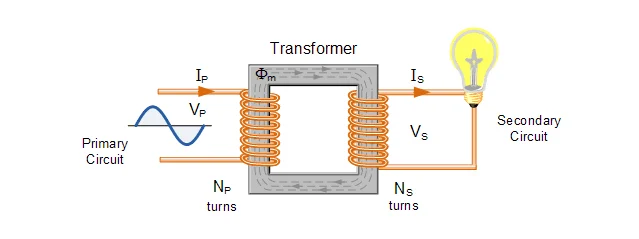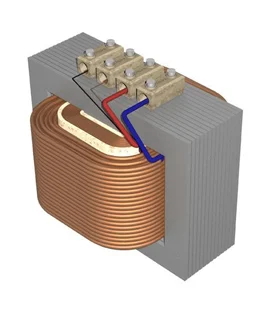In this section you will learn
1. How transformers Work.
2. Principle of operation of transformers
3. What is a step up and step down transformer?
4. What is Induction?
5. Why do transformers have high efficiency?
6. What is the transformer ratio and what is the turns ratio?
7. What are the main materials used for transformer cores?
Transformer is an electrical machine consisting of two or more coils of wire, would around a magnetic material. Transformer is used to transfer electrical energy by step-up or step-down the voltage without changing the frequency at very low energy loss. The electric field is changed to magnetic field and again the magnetic field to electric field. Transformers are very simple static electro-magnetic passive electrical machine that work on the principle of Faraday’s law of induction by converting electrical energy from one form to another. The two electrical circuits are linked through self and mutual induction, which is the process by which a coil of wire magnetically induces a voltage into another coil that is positioned in close vicinity.

As there are no rotating parts in transformer, Electrical energy passes more efficiently from one coil to the other by wrapping the coils around a core. The voltage level is increased or decreased by corresponding decreasing or increasing current, without changing the frequency. Higher AC transmission voltages and currents can be reduced to a much lower, safer, and usable voltage level where it can be used to supply electrical equipment in homes and workplaces.

A single-phase voltage transformer consists of two electrical coils of wire named as primary winding and secondary winding. The primary winding takes power, while the secondary winding delivers power. The two coils are not electrically connected (except auto transformer), but linked magnetically.
In a transformer,
VI=constant,
means V1 x I1 = V2 x I2
Voltage is directly proportional to the number of turns in that coil/winding.
V ∝ T, hence T1 x I1 = T2 x I2
If the Nos of turns in the secondary coil has the same number of turns as the first coil, the electric current in the second coil will be virtually the same size as the one in the first coil.
A step-down transformer is when the primary winding (T1) has more turns than the secondary winding (T2), so the secondary voltage is smaller than the primary voltage. A step-up transformer is when the primary winding (T1) has fewer turns than the secondary winding (T2), causing the secondary voltage to be higher than the primary voltage.
The ratio of secondary voltage to primary voltage (V2/V1) is called transformer ratio(k) which is the same as (T2/T1), But the turns ratio is primary turns to secondary turns (T1/T2). Hence, the turns ratio is 1/k
As stated earlier, the coils are wrapped around a core. The core can be made of a with a good magnetic material. First is the iron core transformer, which uses soft iron plates as the core material. The iron has excellent magnetic properties, causing the flux linkage of the iron core transformer to be high, so the efficiency is also high. A ferrite core transformer uses a ferrite core, which has high magnetic permeability and offers very low losses in the high-frequency applications. Often ferrite core transformers are used in switch mode power supplies or RF related applications.

Toroidal core transformer uses toroid-shaped core material (ring or donut-shaped), such as iron core or ferrite core. The ring shape makes the leakage inductance very low. In an air-core transformer, the flux linkage is made entirely using the air; however, they produce low mutual inductance compared to a transformer with a physical core.
One thought on “How Transformer Works”
Comments are closed.